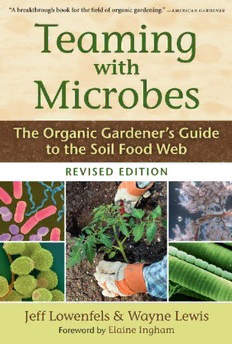
Teaming with microbes: the organic gardener's guide to the soil food web PDF
Preview Teaming with microbes: the organic gardener's guide to the soil food web
Teaming with Microbes This page intentionally left blank Teaming with Microbes The Organic Gardener’s Guide to the Soil Food Web REVISED EDITION Jeff Lowenfels & Wayne Lewis Foreword by Elaine Ingham TIMBER PRESS PORTLAND • LONDON Copyright © 2010 by Jeff Lowenfels and Wayne Lewis. All rights reserved. Disclaimer: The use of the scientifi c term “soil food web” is not intended to promote any commercial activity or to suggest any affi liation with a commercial entity. Published in 2010 by Timber Press, Inc. The Haseltine Building 133 S.W. Second Avenue, Suite 450 Portland, Oregon 97204-3527 www.timberpress.com 2 The Quadrant 135 Salusbury Road London NW6 6RJ www.timberpress.co.uk ISBN-13: 978-1-60469-113-9 Printed in China The Library of Congress has cataloged the hardcover editions as follows: Library of Congress Cataloging-in-Publication Data Lowenfels, Jeff. Teaming with microbes : a gardener’s guide to the soil food web / by Jeff Lowenfels and Wayne Lewis. p. cm. Includes bibliographical references (p. ) and index. ISBN-13: 978-0-88192-777-1 1. Soils. 2. Soil ecology. 3. Soil microbiology. 4. Food chains (Ecology) I. Lewis, Wayne, 1942– . II. Title. S591.L59 2006 631.4—dc22 2005033502 A catalog record for this book is also available from the British Library. We dedicate this book to our wives, Judith Hoersting and Carol Lewis, who allowed us to team with microbes in the fi rst place. They married gardeners and ended up with amateur microbiologists. They let compost tea brew in the kitchen. They put up with fungi, bacteria, nematodes, spiders, and worms. They remained silent when we took the molasses from the cupboard. They learned to turn compost piles and to appreciate mushrooms in our lawns. This page intentionally left blank Contents Foreword by Dr. Elaine Ingham, Ph.D., 9 Preface, 11 Part 1. The Basic Science, 17 Chapter 1. What Is the Soil Food Web and Why Should Gardeners Care?, 19 Chapter 2. Classic Soil Science, 28 Chapter 3. Bacteria, 43 Chapter 4. Archaea, 52 Chapter 5. Fungi, 61 Chapter 6. Algae and Slime Molds, 75 Chapter 7. Protozoa, 80 Chapter 8. Nematodes, 85 Chapter 9. Arthropods, 89 Chapter 10. Earthworms, 96 Chapter 11. Gastropods, 102 Chapter 12. Reptiles, Mammals, and Birds, 105 Part 2. Applying Soil Food Web Science to Yard and Garden Care, 107 Chapter 13. How the Soil Food Web Applies to Gardening, 109 Chapter 14. What Do Your Soil Food Webs Look Like?, 114 Chapter 15. Tools for Restoration and Maintenance, 124 Chapter 16. Compost, 131 Chapter 17. Mulch, 143 Chapter 18. Compost Teas, 148 Chapter 19. Mycorrhizal Fungi, 162 Chapter 20. The Lawn, 172 Chapter 21. Maintaining Trees, Shrubs, and Perennials, 182 Chapter 22. Growing Annuals and Vegetables, 189 Chapter 23. A Simple Soil Food Web Garden Calendar, 199 Chapter 24. No One Ever Fertilized an Old Growth Forest, 203 Appendix. The Soil Food Web Gardening Rules, 205 Resources, 207 Index, 211 This page intentionally left blank Foreword If you go down in the dirt today, you’d better not go alone! For today’s the day the nematodes have their picnic! Sung to the tune of “The Teddy Bears’ Picnic” W hen you are bored looking at “soil” from urban lawns, making up words to popular songs is always good! Soil shouldn’t be so bor- ing, but urban landscapes mean dead dirt. It means being bent over a microscope for long hours looking at . . . nothing but inert particles. Boring. And so, we make up words to songs. Real soil is active, alive, moving! Critters everywhere, doing interesting things! No need to invent new lyrics to old songs. No hours staring through a microscope looking at micrometer after micrometer of boring—nothing hap- pening. Instead, after just a few seconds—movement, life, action! Urban dwellers and other growers have been pouring toxic chemicals on their soils for years, without recognizing that those chemicals harm the very things that make soil healthy. Use of toxics to any extent creates a habitat for the “mafi a” of the soil, an urban war zone, by killing off the normal fl ora and fauna that compete with the bad guys and keep them under control. Recent work strongly indicates that toxic chemicals destroy water quality, soil health, and the nutritional content of your food, because of the loss, eventually, of the benefi cials in the soil. If toxic material was applied only once in your life, the bad situation we have today would not have developed, but typically with that fi rst application, thousands of organisms that were benefi cial to your plants were killed. A few bad guys were killed as well, but good guys are gone, and they don’t come back as fast as the bad guys. Think about your neighborhood: who would come back faster if your neighborhood was turned into a chemical war zone? Opportunistic marauders and looters, that’s who comes back in after disturbances. In the human world, we send in the National Guard, to hold the line against criminals. But in soil, the levels of inorganic fertilizer being used, or the constant applications of toxic pesticide sprayed, mean the National Guard of the soil has been killed, too. We have to purposefully restore the ben- efi cial biology that has been lost. 9
